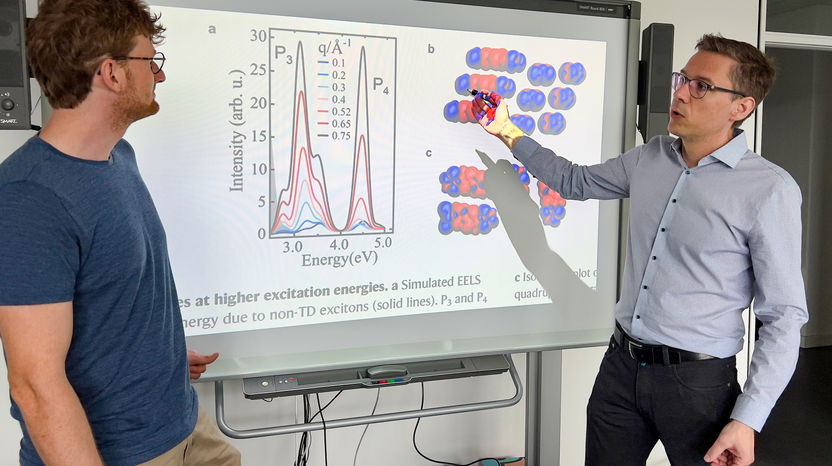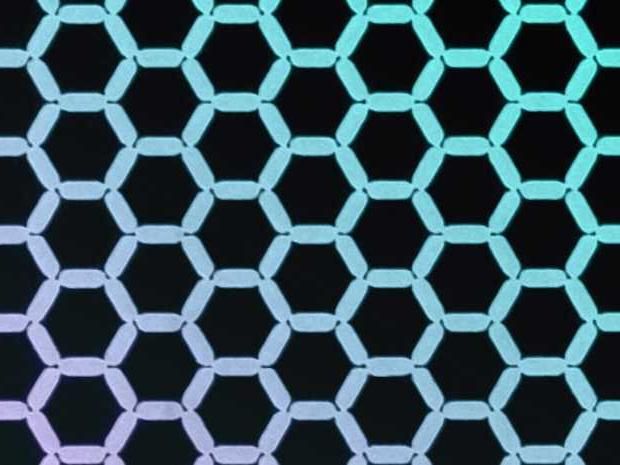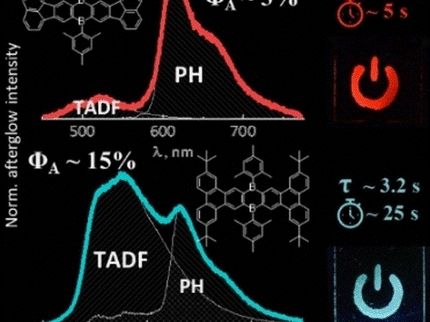How organic solar cells could become significantly more efficient
Turbocharger dyes: Organic dyes accelerate transport of buffered solar energy
The sun sends enormous amounts of energy to the earth. Nevertheless, some of it is lost in solar cells. This is an obstacle in the use of organic solar cells, especially for those viable in innovative applications. A key factor in increasing their performance: Improved transport of the solar energy stored within the material. Now a research group at the Technical University of Munich (TUM) has shown that certain organic dyes can help build virtual highways for the energy.

Prof. Frank Ortmann (right) and Maximilian Dorfner discuss how specific molecules can increase the efficiency of organic solar cells.
S. Reiffert / TUM
Organic solar cells are light, extremely thin energy collectors and as a flexible coating are a perfect fit on almost any surface: Solar cells based on organic semiconductors open up a range of application possibilities, for example, as solar panels and films which can be rolled up, or for use on smart devices. But one disadvantage in many applications is the comparatively poor transport of the energy collected within the material. Researchers are investigating the elementary transport processes of organic solar cells in order to find ways to improve this transport.
Stimulating sunlight
One of these researchers is Frank Ortmann, Professor of Theoretical Methods in Spectroscopy at TUM. He and his colleagues from Dresden focus more than anything on the mutual interaction between light and material – especially the behavior of what are called excitons. "Excitons are something like the fuel of the sun, which has to be used optimally," explains Ortmann, who is also a member of the "e-conversion" Excellence Cluster. "When light energy in the form of a photon collides with the material of a solar cell it is absorbed and buffered as an excited state. This intermediate state is referred to as an exciton." These charges cannot be used as electrical energy until they reach a specially designed interface. Ortmann and his team have now shown that what are referred to as exciton transport highways can be created using organic dyes.
Turbocharger dyes
The reason it is so important that the excitons reach this interface as quickly as possible has to do with their short lifespan. "The faster and more targeted the transport, the higher the energy yield, and thus the higher the efficiency of the solar cell," says Ortmann. The molecules of the organic dyes, referred to as quinoid merocyanines, make this possible, thanks to their chemical structure and their excellent ability to absorb visible light. Accordingly, they are also suitable for use as the active layer in an organic solar cell, Ortmann explains.
Energy packets in the fast lane
Using spectroscopic measurements and models the researchers were able to observe the excitons racing through the dye molecules. "The value of 1.33 electron volts delivered by our design is far above the values found in organic semiconductors – you could say the organic dye molecules form a kind of super-highway," Ortmann adds. These fundamental new findings could pave the way for targeted, more efficient exciton transport in organic solid matter, accelerating the development of organic solar cells and organic light emitting diodes with even higher performance.
Original publication
Other news from the department science

Get the chemical industry in your inbox
By submitting this form you agree that LUMITOS AG will send you the newsletter(s) selected above by email. Your data will not be passed on to third parties. Your data will be stored and processed in accordance with our data protection regulations. LUMITOS may contact you by email for the purpose of advertising or market and opinion surveys. You can revoke your consent at any time without giving reasons to LUMITOS AG, Ernst-Augustin-Str. 2, 12489 Berlin, Germany or by e-mail at revoke@lumitos.com with effect for the future. In addition, each email contains a link to unsubscribe from the corresponding newsletter.
Most read news
More news from our other portals
Last viewed contents
Estée_Lauder_Companies
CBV_(chemotherapy)
Labfolder signs agreement with Max Planck Society - Contract provides up to 11,000 Max Planck scientists access to use labfolder for digital laboratory data management
Museum_of_Neon_Art
Johann_Rudolf_Glauber





























































